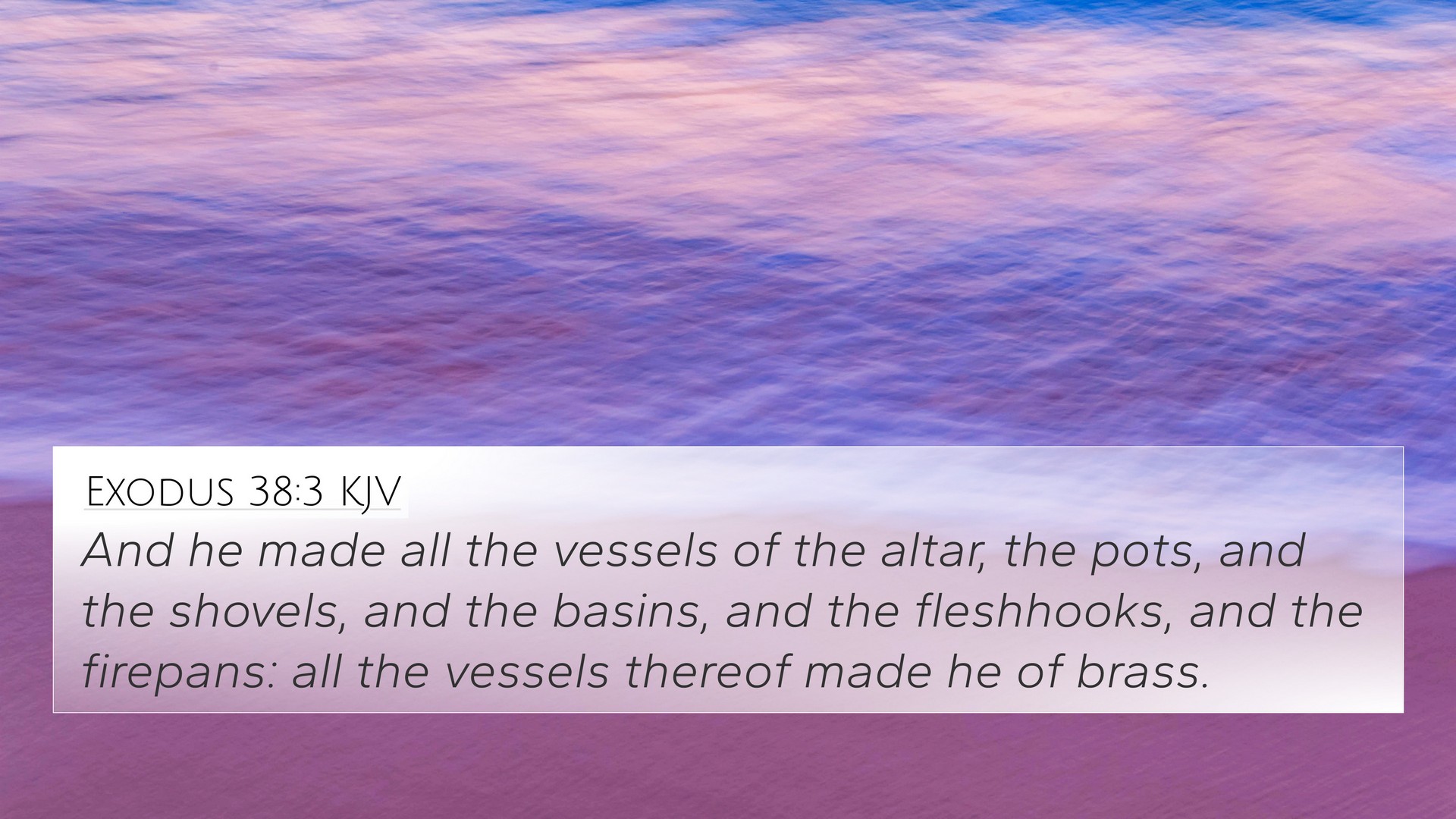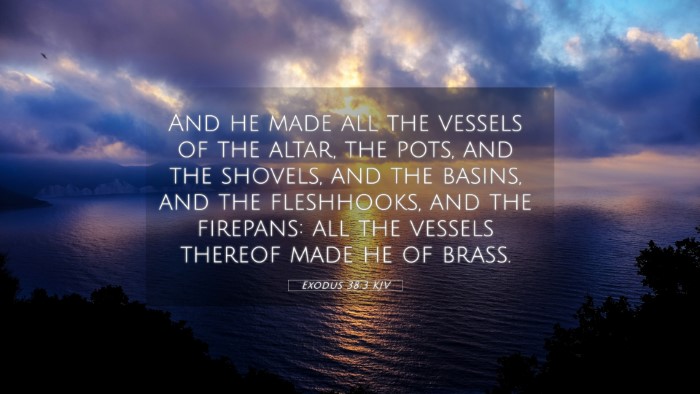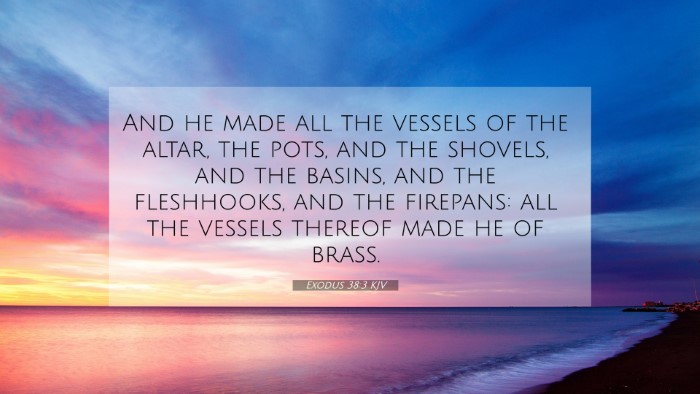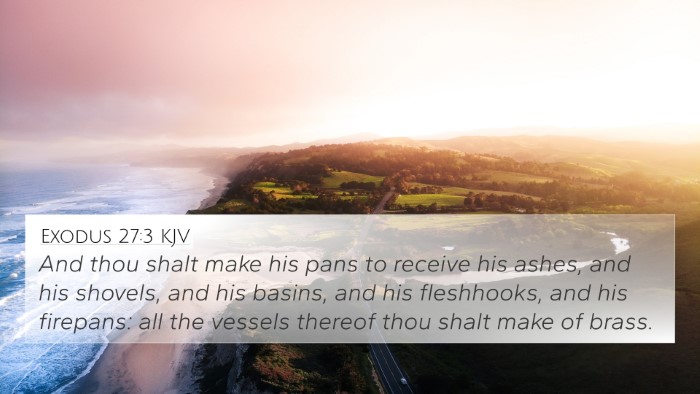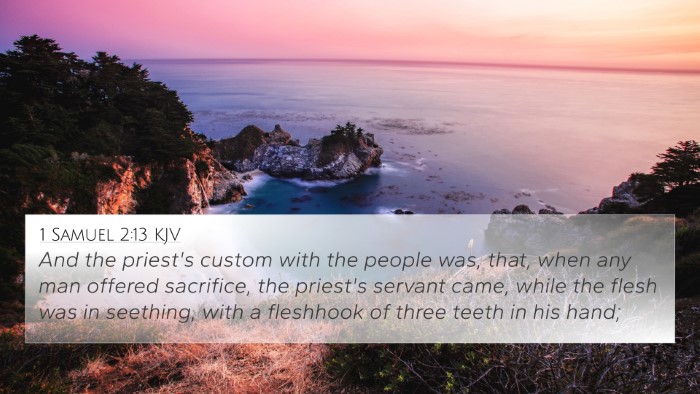Understanding Exodus 38:3
Exodus 38:3 states, "And he made all the instruments of the altar, the pots, and the shovels, and the basins, and the fleshhooks, and the firepans: all the vessels thereof made he of brass." This verse provides significant insights into the construction of the altar and its instruments, which played a vital role in worship practices during the time of the Israelites.
Meaning and Insights
The instruments mentioned in Exodus 38:3 are integral to the sacrificial system, highlighting the importance of proper worship and offerings to God. The use of brass is symbolically significant, as it represents strength and purity in Biblical texts.
Commentary Insights
Matthew Henry's Commentary: Henry emphasizes that the construction of these instruments reflects the meticulous nature of God's commandments. The altar's vessels, made of brass, underscore their durability and the need for purity in sacrificial rites. The brass signifies that these instruments were not just functional but also held spiritual significance as they were used in worship to fulfill God's commands.
Albert Barnes' Notes: Barnes notes that the specific mention of each instrument illustrates the detailed instructions that God provided, which should be adhered to in worship. His commentary indicates that the vessels symbolize various aspects of sacrifice, representing the offerings that were integral to the covenantal relationship between God and His people.
Adam Clarke's Commentary: Clarke points out that the mixing of brass in these vessels could indicate the refinement process both for the materials used and the spiritual preparation required of the Israelites. Additionally, he comments on how these physical instruments prefigure the ultimate sacrifice made in the New Testament, linking the Old Testament practices to Christian theology.
Bible Cross-References
To deepen the understanding of Exodus 38:3, we can examine several cross-references:
- Exodus 27:1-2 - Details about the altar's construction.
- Numbers 4:14 - Discusses the handling of sacred instruments.
- Hebrews 9:9 - References the system of sacrifices in relation to the altar.
- 1 Corinthians 10:18 - Mentions Israel's participation in altar sacrifices.
- Leviticus 1:12 - Instructions on how the offerings were to be made using the altar.
- Romans 12:1 - Encourages spiritual worship as a living sacrifice.
- John 2:19 - Jesus speaks of his body as the ultimate sacrifice, connecting to the sacrificial system.
Thematic Connections
This verse is connected to various themes throughout the Bible:
- Sacrifice and Worship: The altar signifies the place of sacrifice, which is further developed in the New Testament through Jesus' ultimate sacrifice.
- Purity: The use of brass suggests the idea of purity and the need for cleanliness in approaching God.
- Obedience to God's Commands: The detailed instructions emphasize the importance of following God's guidelines closely in worship practices.
Tools for Bible Cross-Referencing
To help in understanding the connections and meanings of various Bible verses, individuals can utilize:
- Bible Concordance: A helpful tool for finding words and associated scriptures.
- Bible Cross-reference Guide: Offers a structured way to find related verses.
- Bible Reference Resources: Resources such as commentaries and online databases can aid in deeper study.
- Bible Cross-reference System: Helps in systematic cross-referencing for general studies and sermon preparation.
Conclusion
Exodus 38:3 serves as a reflection of the intricate worship practices ordained by God, emphasizing the significance of the altar and its instruments. Through cross-referencing this verse with other scriptures, one can appreciate the continuing dialogue throughout the Bible on themes of sacrifice, worship, and obedience to divine commandments.
If you're looking to explore more Bible verses in relation to Exodus 38:3, consider researching passages around the themes of sacrifice and worship in both the Old and New Testaments.
For those wanting to understand how different Bible verses connect, exploring the provided tools and resources will offer a more in-depth perspective on the rich tapestry of scriptural narratives.
